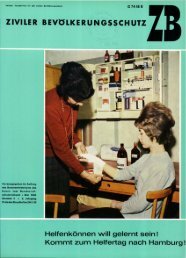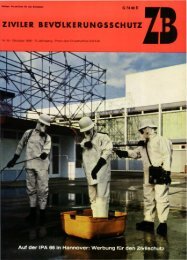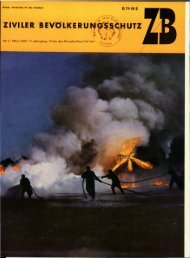Zivilschutz- Forschung - Bundesverwaltungsamt
Zivilschutz- Forschung - Bundesverwaltungsamt
Zivilschutz- Forschung - Bundesverwaltungsamt
Sie wollen auch ein ePaper? Erhöhen Sie die Reichweite Ihrer Titel.
YUMPU macht aus Druck-PDFs automatisch weboptimierte ePaper, die Google liebt.
54. DeAtley, C. (1991). "Hazardous materials exposure mandates integrated<br />
patient care." Occup Health Saf 60(3): 40-4.<br />
55. Dellinger, A. M., R. J. Waxweiler, et al. (1997). „Injuries to rescue workers<br />
following the Oklahoma City bombing.“ Am J Ind Med 31(6): 727-32.<br />
56. Department of Defense (2001). „Chemical and biological defense program“<br />
57. DeRoos, R. L. (1989). „Emergency room guidelines. Providing services to<br />
victims of toxic spills.“ J Environ Health 52(1): 331-3.<br />
58. Deutscher Städtetag (2002).“Reform des Zivil und Katastrophenschutzes in<br />
der Bundesrepublik Deutschland“<br />
59. Dhara, R. (1992). „Health effects of the Bhopal gas leak: a review.“ Epidemiol<br />
Prev 14(52): 22-31.<br />
60. Dhara, R., S. Acquilla, et al. (2001). „Has the world forgotten Bhopal?“ Lancet<br />
357(9258): 809-10.<br />
61. DiGiovanni, C., Jr. (1999). „Domestic terrorism with chemical or biological<br />
agents: psychiatric aspects.“ Am J Psychiatry 156(10): 1500-5.<br />
62. Dikshit, R. P. and S. Kanhere (1999). „Cancer patterns of lung, oropharynx<br />
and oral cavity cancer in relation to gas exposure at Bhopal.“ Cancer Causes<br />
Control 10(6): 627-36.<br />
63. Eckert, W. G. (1991). „Mass deaths by gas or chemical poisoning. A historical<br />
perspective.“ Am J Forensic Med Pathol 12(2): 119-25.<br />
64. Fein, A., A. Leff, et al. (1980). „Pathophysiology and management of the<br />
complications resulting from fire and the inhaled products of combustion:<br />
review of the literature.“ Crit Care Med 8(2): 94-8.<br />
65. Ferner, R. E. (1993). „Chemical disasters.“ Pharmacol Ther 58(2): 157-71.<br />
66. Gabor, T. and C. Pelanda (1983). „Assessing differences in chemical disaster<br />
proneness: the Community Chemical Hazard Vulnerability Inventory.“<br />
Emerg Plann Dig 10(3): 9-16.<br />
67. Gao, L. L., A. Miller, et al. (2000). „Chemical and biological terrorism preparedness<br />
– Web-based resources.“ Appl Occup Environ Hyg 15(8): 592-5.<br />
68. Garrett, L. C., C. Magruder, et al. (2000). „Taking the terror out of bioterrorism:<br />
planning for a bioterrorist event from a local perspective.“ J Public<br />
Health Manag Pract 6(4): 1-7.<br />
69. Gunby, P. (1998). „RAID teams to respond to terrorism threat. Rapid assessment<br />
and initial detection.“ Jama 279(23): 1855.<br />
70. Gunn, S.W.A., Domres, B., Steiner, E.R (1990). „Dictionary of Disaster<br />
Medicine and International Relief” Verlagsgesellschaft Stumpf & Kossendey.<br />
71. Gunnell, D. J. (1993). „The public health physician's role in chemical incidents.“<br />
J Public Health Med 15(4): 352-7.<br />
72. Gupta, B. N., S. K. Rastogi, et al. (1988). „Effect of exposure to toxic gas<br />
on the population of Bhopal: Part I – Epidemiological, clinical, radiological<br />
& behavioral studies.“ Indian J Exp Biol 26(3): 149-60.<br />
225

















